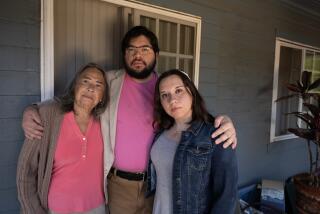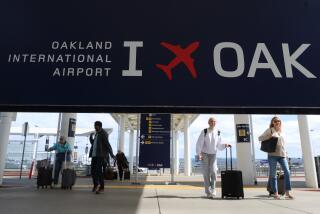A Sign of Pride in a Maligned Area
In Los Angeles’ most maligned neighborhood, they hope to put the skids to one image-polishing idea.
Street people and loft residents have joined forces to block removal of the name “Skid Row” from the sides of firetrucks and rescue ambulances that are assigned to the beleaguered downtown zone.
The name has been painted for decades on equipment that is operated out of Station 9, the 7th Street firehouse that serves the skid row area and proclaims itself “the busiest fire station in the country.”
Firefighters and paramedics -- as well as some residents -- said the skid row label helps instill a feeling of community in a district struggling with homelessness and crime.
But top fire officials say they’ve received complaints that the name is derogatory and ordered “Skid Row” stripped from Station 9’s two fire engines, its hook-and-ladder truck and its two paramedic ambulances.
“If it’s offending people, we don’t want to be doing it,” said Battalion Chief Lou Roupoli, adding that residents of the new condominiums and lofts popping up in the area have complained that the fire engine label is objectionable.
Some of the developers who have been converting old bank buildings into luxury lofts on the edges of skid row have increasingly been using the less-gritty name “Central City East” to describe the district.
Fire officials declined to say who complained. And with firefighters now campaigning to keep the skid row moniker, community leaders are largely trying to stay neutral in the debate.
They said they want to support the firefighters but also understand that the term can have a negative connotation -- to both new residents and the poor who have long called the district home.
“It’s a badge of honor to firefighters. They’re adamant it should be ‘Skid Row.’ But a lot of people in subsidized housing feel stigmatized by the name,” said Brady Westwater, the elected president of the Downtown Los Angeles Neighborhood Council, which has not taken a position on the issue. “They feel the skid row name is a barrier to having a positive image of the area.”
Yet many others have responded by circulating petitions calling on fire officials to reconsider their decision.
Transients are helping collect signatures on the streets while loft residents gather them in storefront shops and studios carved out of former factories and office buildings scattered around skid row.
“As off-beat and off-color as it might sound, there is a sense of community pride here,” said Cherry Wood, a Web and graphics designer who has resided more than 10 years in downtown Los Angeles. “You know what? There are a lot of really nice people in skid row. People don’t understand that unless they live here. Even people who don’t like the name ‘Skid Row’ support the firefighters who want to keep the name on the trucks.”
Wood said she and others learned of the name ban after firefighters responded to a recent refrigerator fire in their building. It is a converted 1926 paper factory between 5th and 6th streets.
“It was a small fire. But it put out a tremendous amount of smoke that filled the whole building. Everybody ran out when the alarms went off,” Wood said. “A bunch of us were taking pictures.”
Residents later decided to take copies of their photos to Station 9 as a thank-you gift to firefighters. Wood said firefighters became emotional when they saw pictures clearly depicting the “Skid Row” name on the engines. They explained that the name had been ordered deleted.
“The guys like it. It’s become a term of endearment. It shows that, hey, this is our area,” said Station 9 Capt. Cedrick Cleveland, who leads Station 9’s two-engine crew.
Cleveland told the residents that firefighters didn’t know who had complained about the skid row engine labels or found them derogatory.
“We know there’s a hard push to clean up the area, to eliminate the homelessness. It’s getting a lot of press. That’s the only conclusion we came to,” Cleveland said.
To the firefighters at Station 9, the skid row name is more than just a way of identifying the neighborhood they serve. They take pride working at what is considered the toughest assignment in the Los Angeles Fire Department, where the station can respond to more than 60 calls a day. Off-duty firefighters also wear T-shirts printed with the slogan “Wino Nino Firehouse Skid Row.”
Wood is now leading the petition drive, and she says she’s finding much support for the name.
“Does taking the name off the trucks change where we’re at?” asked Willie Wilson as he signed the save skid row petition for her as he sat this week in San Julian Park.
Wes Sams, who lives in a single-room unit on Wall Street, was offended that the name was being removed.
“What petty group is trying to do that?” Sams demanded. “Maybe it’s those people moving into these elaborate lofts. It’s not right.”
This is not the first time Los Angeles has grappled with a neighborhood name that some consider a liability. Three years ago, the City Council voted to change South-Central Los Angeles to South Los Angeles, saying South-Central brought with it a stigma of gang activity and drugs. The city has also changed the names of several neighborhoods in the San Fernando Valley -- portions of Sepulveda became North Hills -- for similar reasons.
Officials of the Central City East Assn. said that while they believe the term skid row has a negative connotation, they have not called for it to be removed from the trucks.
“Whenever I see the trucks and the words ‘Skid Row,’ I always smile,” said Estela Lopez, executive director of the nonprofit advocacy group for area property owners. “If we really want to clean up skid row, we shouldn’t worry about what’s on the side of the fire engines. We should be worried about what’s on the streets.”
Records indicate that the skid row name in Los Angeles dates from 1939, when an essay labeled “Skidrow Serenade” was published in The Times. The article chronicled the area’s “10,000 transients, variously called tramps, hobos, hitchhikers, bindle stiffs and other names not so nice,” noting that “sooner or later every one of these wanderers will find his way down to 5th Street and Towne Avenue ... the heart of Skidrow.”
The name was first applied to an area in Seattle where an early-1900s wharf-area lumber operation attracted transient workers who moved logs by dragging them along what locals called “Skid Road.”
Back at Station 9, some of the 51 firefighters, who are divided into three round-the-clock shifts, said they would hate to see the label go.
“Its been on there 20 years,” said Justin Bactat, an apparatus operator on the hook-and-ladder. “We wear that name with pride.”
Fire Capt. Walter Duffy said those in skid row view it that way too.
“People shout out, ‘Hey, you guys are our fire station. You guys are our fire department,’ when they see us,” Duffy said.
Firefighters have invited downtown-area City Councilwoman Jan Perry to have dinner at the 46-year-old firehouse next month so they can discuss skid row and other issues.
Perry said she favors public hearings, which would gauge community reaction to the firetruck name before she takes a stand. Some have recommended a whole new official designation for the skid row area -- such as the “Hope Central” name that one homeless mission has floated, she said.
“People have strong feelings about this,” Perry said.
More to Read
Sign up for Essential California
The most important California stories and recommendations in your inbox every morning.
You may occasionally receive promotional content from the Los Angeles Times.











